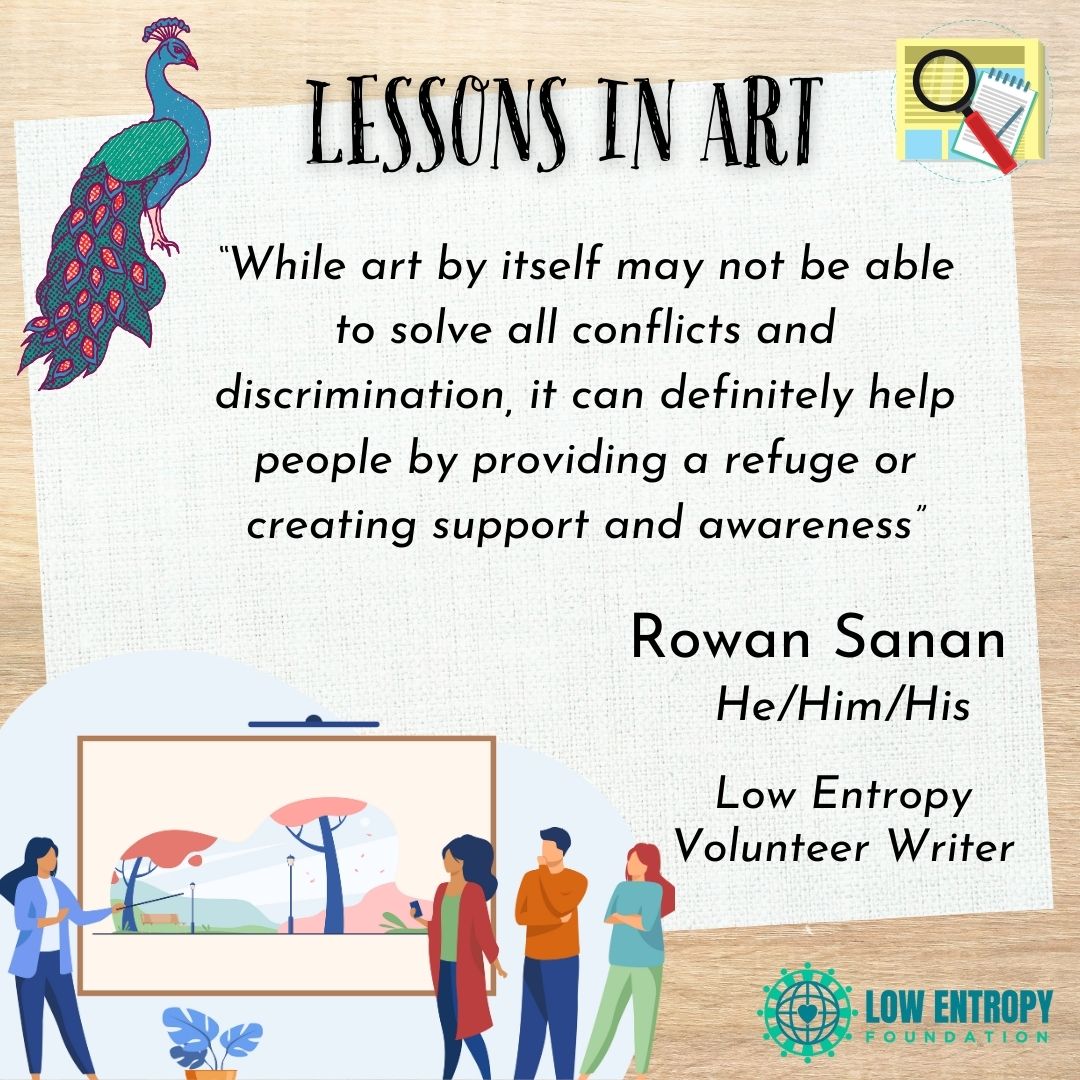Rowan Sanan (he/him/his), Low Entropy Volunteer Writer
Art tells us a lot more than we think.
As part of my required university credits, I was able to take a class that delved into the analysis of artworks of all kinds. I always had a sort of baseline understanding of art analysis from various elementary and high school classes over the years, but I had never done a fully dedicated course on art until then. It was a tough course, but it really showed me a lot about the thought that went behind art and the meanings we as viewers could take away from it. I think that mentality can go beyond visual art forms and can also apply to art like music, drama, dance, film, and more. I also think it can impact our communication with other people, our empathy, our ability to breach difficult subjects with art and our understanding of media in the modern age.
Just learning about art can improve vital skills. Perceiving a piece of art and being able to verbalize what you see going on is a useful skill when you are able to analyze it in depth. While it might seem like a bit of a stretch, that kind of attention to detail and perception can be really helpful in problem-solving situations. For example, part of analyzing artwork includes considering the artist’s perspective and historical context, as well as what messages they may be trying to portray. Think about when people around you are caught up in an argument. If you have the skills to consider both sides of the argument in a fair and impartial way, that can help you bring the argument to an amicable end.
Part of discussing art also considers one’s own opinions and viewpoints, which can change greatly based on people’s perspectives and experiences. Applying that to the argument example, someone with these skills can consider the argument both impartially and in an empathetic, respectful way. This can help all sides of the issue feel understood and seen.
Similarly, this ability to solve issues can also be practiced in ways that are a bit more vague, like when it comes to discussing certain difficult or different subjects. Art gives many people an outlet or a way to connect with others, which is extremely valuable in the upkeep of communities. Human-made art is instilled with our humanity in that way. It helps us discuss the things that sometimes aren’t received well otherwise. For example, take Lady Gaga’s song “Born This Way,” which has been a sort of anthem for the LGBTQ+ community for many years. It brought awareness to the discrimination that the LGBTQ+ community faces, promoting and uplifting the community in a positive way that anyone could hear worldwide. Not only does this kind of media increase awareness, but some might hear it and grow more accepting of the LGBTQ+ community. In this way, art forms can cross divides between people and show the truth to some who may be a bit more closed off.
Speaking of music and art, they are also incredible mediums within the online world as much as they are within the offline one. With the online reach of these mediums, we have seen public outpourings of support for groups across the world facing injustices—from Ukraine to Palestine, to BIPOC and LGBTQ+ people in the United States of America, to Indigenous people in Canada, and more. I often get artwork on my feed displaying the flags of affected countries, or depicting the faces, symbols and names of victims.
These difficult topics are often made easier to address through the lens of art, which can increase awareness and empathy across the world. While art by itself may not be able to solve all conflicts and discrimination, it can definitely help people by providing a refuge or creating support and awareness.
Having media literacy during these times of development and innovation is extremely important, especially when it comes to art. Art mediums are constantly changing and evolving, for better or for worse. To me, a great lesson can be learned from these changes. The evolution of 3D animation in comparison to 2D, or even live action, for example, is a very interesting lesson in what audiences like to see and in what medium. Many recent live-action remakes have faced harsh criticisms and scathing reviews in recent years, while many animated shows and movies have received a lot of viewership and highly rated reviews. While both live action and animated films are art in their own way, something can be said for the prevalence of animation in the media people like to consume. However, the production of animated media sometimes causes hardships, especially on the hard-working animators who are sometimes not compensated well, or are overworked within tight budgets and schedules.
Media literacy and ensuring art is made ethically and fairly is vital as the media world seems to move further toward speed and quantity over quality and fairness. Don’t even get me started on the ethical/environmental impacts of AI-generated art!
In the end, consuming and creating art is inherently instilled with messages and hints, whether intentional or not. Being able to pinpoint these can help us in our daily lives to solve issues, be better people to each other, and confront injustices and hardships in productive ways.
—
Rowan is a university student who loves to write books and poetry, read all kinds of books and spend time with his family and pets.
—

